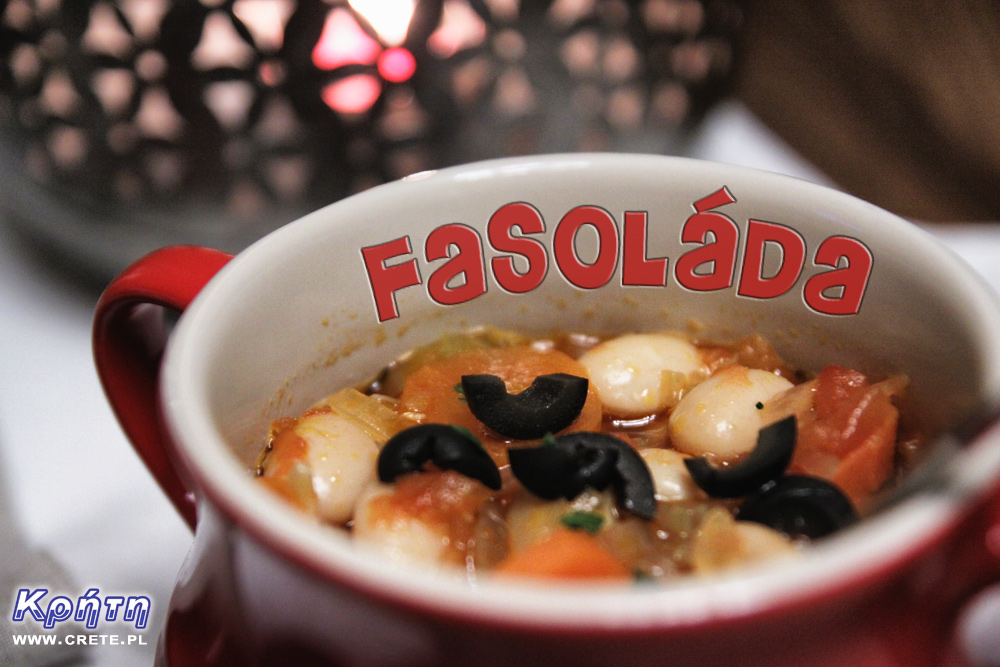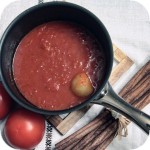

Fasoláda is a Greek bean soup considered one of the most popular soups of this country. Fantastically suited for winter days, because it is thick, warming and filling. Despite the fact that it is not cooked on meat, and its main ingredients are only vegetables, this soup is delicious, full of flavor and aroma. In our home, it has permanently entered the canon of favorite soups.
It takes a lot of time to prepare the beans, but its taste fully compensates for the length of preparing this soup. It is also worth remembering that dried bean grains are used for beans, which must be pre-soaked earlier. We serve the finished fasoláda with chopped black olives. Alternatively, you can sprinkle it with a bit of chopped parsley. We highly recommend it!
1. Fill beans with plenty of water and let them soak overnight. On the second day we pour water, rinse the beans under running cold water and pour water again in a pot.
2. Boil on high heat and boil for 10 minutes. After this time, reduce the heat, cover and cook for about half an hour.
3. At this time, we prepare vegetables. We slice the onion and garlic quite thickly, peeled carrot and celery stems cut into thin slices. Tomatoes from the can are mixed in a blender.
4. After half an hour, add the chopped vegetables, tomatoes, sugar, olive oil, thyme and bay leaf to the pot with the cooked beans. Fry the onions for glazing in olive oil and also add to the soup. Season with pepper. After boiling, cover the pot with a lid and slowly simmer until the beans are soft. On average it will take about an hour.
5. At the end, to taste, season the soup with salt. We have not used salt before, because its use would make the beans hard. Serve with chopped olives and possibly parsley. It will also taste great with feta.
Καλή όρεξη!


Each kitchen in the world has its own way to tomato sauce, but the most important difference is in the spices that the individual nations spice up the simplest and best of sauces. The variety of spices that are popular in a given region of the world is also landing in a tomato sauce every day. We love tomatoes in absolutely every form, so every day the sauce made from them reigns in different forms.

The presented vegetable soup with the addition of xinochodros is tasty but completely different in taste than traditional Polish vegetable soups. It is also simple and fast to prepare. And in addition to xinochondros it does not require any other Cretan specialties.

Recently, we wrote about xinochondros, or a specific Cretan product made from wheat grains and sour milk. Today we will present the first method of using xinochondros in a very simple and surprisingly tasty tomato soup. Its bready and slightly sour taste makes it completely different from our soups.
Komentarze
komentarz z
Ale smaka robicie ;) uwielbiam :D
komentarz z
Ta zupa jest fenomenalna. Dopiero co zjedliśmy garnek tej zupy i już mamy ochotę na powtórkę :)
komentarz z
Wiem ze jest fenomenalna ale teraz nie moge bo nie mam woreczka,,,,,,,,kiedys jadlam jak pracowalam w Grecji ......pozdrawiam .
komentarz z
Cóż możemy Ci napisać, strasznie nam przykro z tego powodu.
komentarz z
Pyszna...polecam :)
komentarz z
P Y C H O L A D A ;)
"fasolada,najbardziej lubiana,poprawiająca nastrój potrawa w Grecji"
Ten powyższy cytat pochodzi z książki "Smakując Grecję "; dziś do domu wróciłam zamarznięta a tam czekała gorrrąca fasolada! Pyszna! Szkoda,że człowiek żołądek ma taki mały! Zupa ugotowana wg waszego przepisu. Mniam mniam, dziękuję
Wypełnij poniższy formularz aby dodać komentarz
lub kliknij w poniższy link aby skorzystać z możliwosci komentowania przez facebooka:
https://www.facebook.com/crete.poland/posts/10153235271737551